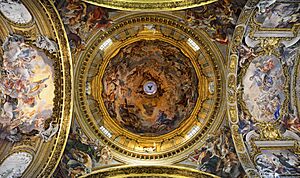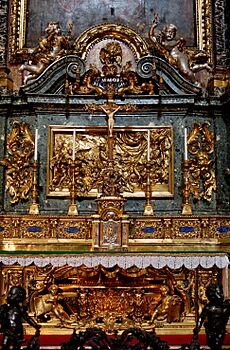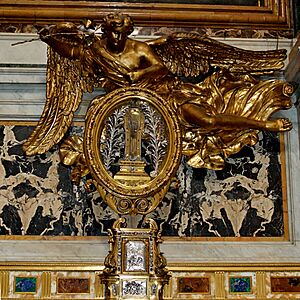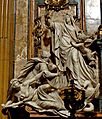Church of the Gesù facts for kids
Quick facts for kids Church of the Gesù |
|
|---|---|
| Church of the Most Holy Name of Jesus | |
|
Chiesa del Santissimo Nome di Gesù (Italian)
|
|
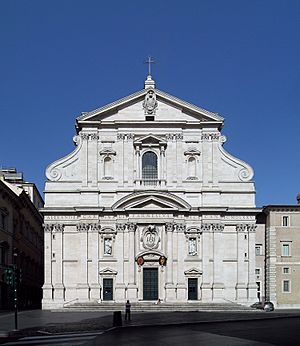
The church's front, or façade, was designed by Giacomo della Porta. It is an early example of the Baroque style.
|
|
| 41°53′45″N 12°28′47″E / 41.89583°N 12.47972°E | |
| Location | 54 Piazza del Gesu, Rome |
| Country | Italy |
| Denomination | Catholic Church |
| Religious institute | Jesuits |
| History | |
| Status | Mother church of the Society of Jesus, titular church |
| Dedication | Holy Name of Jesus |
| Consecrated | 1584 |
| Cult(s) present | Sacred Heart of Jesus Madonna Della Strada |
| Relics held |
|
| Architecture | |
| Functional status | Active |
| Architect(s) | |
| Style |
|
| Groundbreaking | 1568 |
| Completed | 1580 |
| Specifications | |
| Length | 75 metres (246 ft) |
| Width | 35 metres (115 ft) |
| Nave width | 25 metres (82 ft) |
| Other dimensions | Façade direction: W |
| Number of domes | 1 |
| Administration | |
| Diocese | Rome |
The Church of the Gesù is a famous Catholic church in Rome, Italy. Its full name in Italian is Chiesa del Santissimo Nome di Gesù, which means Church of the Most Holy Name of Jesus.
This church is very important because it is the "mother church" of the Society of Jesus, a religious group also known as the Jesuits. This means it's the main headquarters for Jesuits all over the world.
The front of the church, called the façade, was the first of its kind in the Baroque style. This grand and decorative style became very popular. The Church of the Gesù became a model for hundreds of other Jesuit churches built across Europe and the Americas. Its amazing paintings and decorations also inspired art in many other churches.
Contents
History of the Church
The idea for the church came from Saint Ignatius of Loyola in 1551. He was the founder of the Jesuits. This was during the Counter-Reformation, a time when the Catholic Church was making changes to strengthen its faith.
A wealthy and powerful cardinal named Alessandro Farnese paid for the church to be built. The main architects were Giacomo Barozzi da Vignola and Giacomo della Porta. Construction started in 1568 on the same spot where an older church, Santa Maria della Strada, once stood.
The church was designed to be different from older churches. It has one large open area called a nave, instead of long side aisles. This way, everyone in the congregation could easily see the main altar and clearly hear the priest's sermon. This was very important to the Jesuits, who were known for their powerful preaching. The church was officially opened and blessed in 1584.
The Church's Exterior
The front of the church, or façade, was designed by Giacomo della Porta. It is made of two main levels. The lower level is wide and has columns framing the three doors. The main door is decorated with the letters IHS. This is a symbol for the name of Jesus.
Statues of two important Jesuit saints stand on either side of the façade. On the right is Saint Francis Xavier, and on the left is Saint Ignatius of Loyola. The upper and lower sections of the façade are connected by large, scroll-shaped supports called volutes. This design gives the building a grand and dynamic look.
Inside the Church
The inside of the Church of the Gesù is filled with incredible art. It is a stunning example of the Baroque style, with colorful marble, gold details, and amazing sculptures and paintings everywhere you look.
The Amazing Ceiling Fresco
The most famous feature inside the church is the giant painting on the ceiling of the nave. It is called the Triumph of the Name of Jesus and was painted by Giovanni Battista Gaulli between 1678 and 1679.
The painting is a masterpiece of trompe l'oeil, which is French for "trick the eye." Gaulli painted figures on curved plaster that seem to be floating right out of the ceiling and into the church. It creates a stunning 3D effect that makes it look like the ceiling is open to heaven.
Chapel of Saint Ignatius of Loyola
On the left side of the church is the magnificent chapel dedicated to Saint Ignatius, the founder of the Jesuits. Designed by Andrea Pozzo, this chapel is one of the church's greatest treasures. The altar features a huge statue of the saint, which is a copy of an original silver one.
The altar is decorated with columns covered in lapis lazuli, a rare and beautiful blue stone. Below the altar, two large marble sculptures show Religion defeating heresy and Faith defeating idolatry.
The chapel also has a "baroque machine." Every day at 5:30 PM, music plays and a large painting is slowly lowered to reveal the glowing statue of St. Ignatius. This dramatic display was designed to inspire wonder and faith in visitors.
Chapel of Saint Francis Xavier
On the right side of the church is a chapel dedicated to Saint Francis Xavier, one of the first Jesuit missionaries. The altarpiece shows the Death of Francis Xavier by the artist Carlo Maratta.
This chapel holds a special silver container, called a reliquary. It contains the right arm of Saint Francis Xavier. It is said that he used this arm to baptize thousands of people during his travels in Asia.
A Model for the World
The design of the Church of the Gesù was so successful that it was copied all over the world. Jesuit churches from Munich, Germany, to Córdoba, Argentina, were inspired by its grand style. It set the standard for what a Jesuit church should look like for centuries.
Gallery
See also
 In Spanish: Iglesia del Gesù para niños
In Spanish: Iglesia del Gesù para niños
- Church of the Gesu (Frascati)
- History of early modern period domes
- List of Jesuit sites


